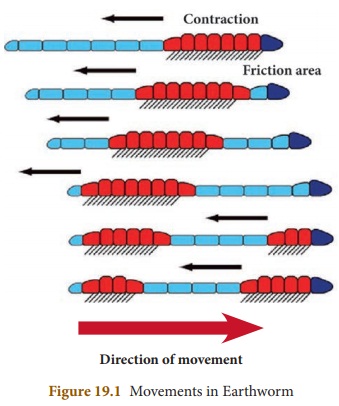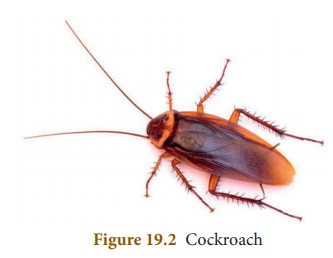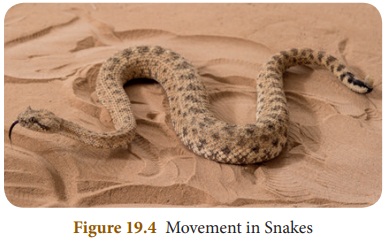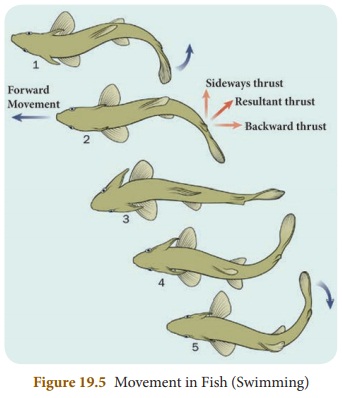Movements in Animals | Chapter 19 | 8th Science - Movement in different Animals | 8th Science : Chapter 19 : Movements in Animals
Chapter: 8th Science : Chapter 19 : Movements in Animals
Movement in different Animals
Movement in different Animals
Movement is one of the significant
features of living beings. This is the basic mechanism used in majority of the
vertebrates including human. Animals exhibit a wide range of movements. In this
part let us study about movements in different animals.
Earthworm
The body of earthworm is made up of
many rings joined end to end. It has muscles which help to extend and shorten
the body. Under its body it has large number of bristles called setae which are
connected with muscles. These bristles help to get grip on the ground. During
movement, the earthworm first extends the front part of the body, keeping the
rear portion fixed to the ground.
Activity 1
Observe an earthworm
moving on soil in the garden. Gently lift it and place it on a piece of
blotting or filter paper. Observe its movement now. In which of the above two
surfaces do you find that the earthworm is able to move easily?

Then it fixes the front end and
releases the rear end. It then shortens the body and pulls the rear end forward.
This makes it move forward by small distances. Repeating such muscle
contraction and relaxation the earthworm can move through soil. A slimy
substance secreted by its body helps this movement.
Cockroach
A cockroach has three pairs of
jointed legs, which help it to walk, run and climb. It also has two pairs of
wings for flying. Large and strong muscles help in the movement of legs. The
body is covered by chitin, a light protective material. Chitin is shed
regularly so that the body can grow.

Activity 2
Observe a cockroach
and identify its legs and wings. Try to know more about other parts of
cockroach with the help of your teacher.
Birds
Birds can walk on the ground and fly
as well. Some birds can also swim in the water. A bird has streamlined body.
Its bones are light and strong. They are hollow and have air spaces between
them. The lower portion of limbs are modified as claws, which help them to walk
and to perch. The breast bones are modified to hold massive flight muscles
which help in moving wings up and down. Birds have special flight muscles and
the forelimbs are modified as wings.The wings and tail have long feathers,
which help in flying. Birds show two types of flight: gliding and flapping.
During gliding the bird has its
wings and tail spread out. In this movement the bird uses air currents for
going up and down. Flapping is an active flight. The bird beats the air by
flapping its wings. They use flight feathers for this purpose.

Activity 3
Observe a hen and
crow. How do they move? Write about the similarities and dissimilarities found
among them, in your note book.
Snake
The body of snake consists of a
large number of vertebrae. The adjoining vertebrae, ribs and skin are
inter-connected with slender body muscles. When the snake moves, it makes many
loops on its sides. The forward push of the loops against the surface makes the
snake move forward. Movement of snake is called slithering movement. Many
snakes can swim in water also.

Since snakes do not
have legs, they use their muscles and their scales to move.
Fish
Fish swims with the help of fins.
They have two paired fins and an unpaired fin. The body of a fish is
streamlined to reduce friction while moving in water. They have strong muscles,
which help in swimming. When a fish swims its front part curves to one side and
the tail part stays in the opposite direction. In the next move, the front part
curves to the opposite side and the tail part also changes its position to
another side. The caudal or tail fin helps in changing direction.
Fish have streamlined body structure
which helps them to move smoothly with the flow of water. Muscles and fins on
the body and the tail help to keep the balance.

Activity 4
Make a paper boat; put
it in water and push it with narrow end pointing forward. Now hold the boat
side way and push it into water from the broad side. What did you observe? In
which process was it easy to move the boat? Have you noticed that the shape of
a boat is somewhat like a fish?
Movements in Human
body
Humans can move some parts of their
body in different directions; however some body parts can be moved only in one
direction. Our body is made up of a frame work of bones called skeleton which helps in the movement of
the body. Some of the movements in body parts of human are:
a. Movement of eyelids.
b. Movement of the heart muscles.
c. Movement of teeth and jaw.
d. Movement of arms and legs.
e. Movements of head.
f. Movements of neck.
Movement of some organs happens
because of the combined action of bones and muscles. In such cases, movement is
possible along a point where two or more bones meet.
• Cheetah can run 76 kilometrer
per hour.
• Hippopotamus can run
faster than a man.
• Cockroach is the
fastest animal with 6 legs covering a metre per second.
• The fastest mammal,
the Dolphin can swim upto 35 miles per hours.
Related Topics